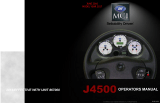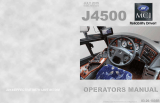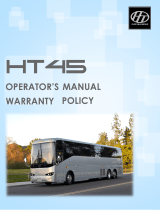
ii TABLE OF CONTENTS
DASHBOARD ............................................42
CONTROL SWITCHES .............................43
L.H. DASHBOARD PANEL........................43
R.H. DASHBOARD PANEL.......................49
AUDIOVISUAL CONTROLLER ...................51
VR300 CD/AM/FM/ STEREO RECEIVER...52
SATELLITE RADIO......................................52
HVAC CONTROL UNIT...............................53
AIR REGISTERS.........................................54
CLUSTER ..................................................55
MESSAGE CENTER DISPLAY (MCD)........55
GAUGES .....................................................55
VEHICLE CLEARANCE INFORMATION.....57
TELLTALE PANEL.......................................58
STEERING COLUMN CONTROLS...........64
MULTI-FUNCTION LEVER..........................64
STEERING WHEEL CONTROLS................65
HORNS........................................................67
TRANSMISSION RETARDER.....................67
FOOT-OPERATED CONTROLS...............68
BRAKE PEDAL............................................68
ACCELERATOR PEDAL.............................68
STEERING WHEEL ADJUSTMENT UNLOCK
AIR VALVE..................................................68
ALLISON TRANSMISSION .......................68
OPERATION ...............................................69
PUSHBUTTON SHIFT SELECTOR.............69
FUNCTIONS OF THE «MODE» BUTTON ..69
TRANSMISSION SERVICE INDICATOR....69
DESCRIPTION OF AVAILABLE RANGES..70
ZF-ASTRONIC AUTOMATIC
TRANSMISSION........................................71
RANGE SELECTOR KEYPAD ....................71
INDICATOR LIGHT......................................71
DISPLAY......................................................71
ACCELERATOR PEDAL.............................71
AUTOMATIC MODE....................................72
MANUAL MODE..........................................72
EASY START SYSTEM...............................72
DRIVING TIPS.............................................72
STARTING THE ENGINE............................73
SETTING OFF, FORWARD TRAVEL..........73
CORRECTING THE STARTING GEAR ......73
MANEUVRING MODE.................................73
STARTING TO ROLL ON SLOPES.............74
CHANGING BETWEEN MANUAL AND
AUTOMATIC MODE....................................74
CHANGING GEAR ......................................74
REVERSING................................................75
CHANGING DIRECTION OF TRAVEL........76
STOPPING VEHICLE..................................76
SWITCHING OFF ENGINE / PARKING
VEHICLE .....................................................76
TOWING......................................................76
CLUTCH PROTECTION..............................77
ENGINE OVERSPEED PROTECTION .......77
ZF-ASTRONIC DISPLAY.............................77
OTHER FEATURES.................................79
EXHAUST AFTERTREATMENT SYSTEM
...................................................................79
AFTERTREATMENT DEVICE.....................79
PASSIVE REGENERATION........................79
ACTIVE REGENERATION..........................79
STATIONARY REGENERATION ................79
MESSAGE CENTER DISPLAY (MCD).....80
DRIVING MODE MENU ............................80
GAUGE MODE MENU.................................80
FUEL ECONOMY MENU.............................80
TIME / DIST. MENU.....................................80
FAULT ? MENU...........................................82
NON-DRIVING MODE MENU...................82
SET UP MODE MENU.................................82
SYSTEM DIAGNOSTIC MENU...................85
DATA LOG MODE.......................................87
PASSWORD INPUT....................................87
PRODRIVERTM ................................................................ 87
TRANSMISSION RETARDER ..................88
ENGINE BRAKE........................................88
WITH DDC SERIES 60 ENGINE.................88
WITH VOLVO D13 ENGINE........................89
ANTILOCK BRAKING SYSTEM (ABS) –
AUTOMATIC TRACTION CONTROL (ATC)
– ELECTRONIC STABILITY PROGRAM
(ESP) .........................................................90
DRIVER CONTROLLED DIFFERENTIAL
LOCK (DCDL)............................................90
KNEELING SYSTEM.................................91
HI-BUOY....................................................91
LOW-BUOY...............................................92
RETRACTABLE TAG AXLE......................92
IN-STATION LIGHTING............................92
COOLANT HEATER..................................92
SWITCHING THE HEATER ON..................93
SWITCHING THE HEATER OFF ................93
COOLANT HEATER TIMER........................93
TROUBLESHOOTING & MAINTENANCE ..95
GPS NAVIGATION SYSTEM....................95
WHEELCHAIR LIFT ..................................95
WHEELCHAIR LIFT AND
ACCESS DOORS........................................95
OPERATING THE
WHEELCHAIR LIFT.....................................96
THRESHOLD WARNING SYSTEM.............96
INTERIOR APPOINTMENTS ......................98
EMERGENCY OPERATION......................100
WHEELCHAIR LIFT REMOVAL FOR
STORING OR MAINTENANCE PURPOSES
...................................................................102
WHEELCHAIR LIFT INSTALLATION........102
STARTING & STOPPING PROCEDURE105
STARTING THE ENGINE .......................105



































